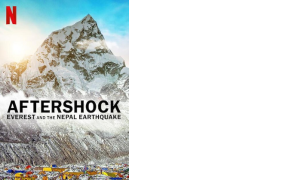
Feb 17 2025.
views 72Struggling to navigate the ever-expanding world of streaming services and on-demand content? Feeling lost in a sea of options, unsure of what to watch next? Worry no more, because The Watchlist Whisperer is here to guide you! We'll be your trusted source for must-watch picks, from captivating dramas and laugh-out-loud comedies to thrilling documentaries and thought-provoking films. Consider us your personal concierge for all things screen-worthy. So, grab your remote, settle in, and get ready to discover your next obsession with The Watchlist Whisperer!
This week on The Watchlist Whisperer, we’re diving into two documentaries that couldn’t be more different if they tried - one takes you to the chaotic, chair-throwing world of daytime TV, while the other drops you into the heart of a real-life disaster on the world’s tallest mountain. It’s the kind of contrast that proves just how wild and unpredictable real life can be. Whether you’re in the mood for a behind-the-scenes look at the outrageous spectacle that was The Jerry Springer Show or a gripping, gut-wrenching retelling of the 2015 Nepal earthquake, we’ve got you covered.
Jerry Springer: Fights, Camera, Action

Back when I lived in the U.S., The Jerry Springer Show was one of those guilty pleasure TV distractions I’d occasionally get sucked into. It was loud, ridiculous, and utterly shameless—the kind of thing you’d stumble upon while flipping channels and somehow end up watching for an hour. Fists flying, chairs soaring, people screaming over paternity tests while Jerry sat there with that signature smirk - it was a chaotic mess, and that was exactly the point. At the time, I never really thought much about it. It was just there - a mindless dose of trash TV that you didn’t have to invest in.
But watching Jerry Springer: Fights, Camera, Action now? That’s a whole different experience. This documentary peels back the layers of what was really going on behind the scenes of one of the most infamous talk shows of all time. And let’s just say, the younger me had no idea how carefully orchestrated the madness really was.
Turns out, all those wild, over-the-top confrontations weren’t quite as spontaneous as they seemed. The documentary lays out how producers carefully engineered each segment, stirring the pot just enough to guarantee maximum drama. Guests were nudged, manipulated, and sometimes outright baited into explosive arguments, all for the sake of ratings. The show preyed on vulnerable people - many of whom were struggling with real-life issues - and turned their pain into primetime entertainment. And the audience? They ate it up, cheering and booing like they were at a wrestling match.
It’s strange looking back now, knowing how much Springer contributed to the rise of reality TV as we know it. It took the messiest parts of human relationships, turned them into spectacle, and made us believe it was real. Long before social media thrived on viral meltdowns and public callouts, Springer had already perfected the formula. But at what cost?
Looking back, it’s wild to realize just how much we bought into it. Springer wasn’t just about entertainment - it was about exploitation, packaging human conflict into bite-sized, meme-worthy moments long before social media made that the norm. If you ever watched an episode without a second thought (and let’s be honest, we all did at some point), this documentary might make you see it in a whole new light.
Aftershock: Everest and the Nepal Earthquake

I still remember reading about the devastating 2015 Nepal earthquake when it happened. The images of collapsed buildings, landslides, and terrified people fleeing through the streets were everywhere. But what I didn’t fully grasp at the time was just how catastrophic it was - not just in Kathmandu, but on the world’s highest peak. Aftershock: Everest and the Nepal Earthquake takes us right into the heart of the disaster, showing the sheer scale of destruction, the resilience of survivors, and, of course, the worst and best of human nature.
The documentary follows climbers, Sherpas, and locals as they fight to survive in the aftermath of an earthquake that triggered deadly avalanches on Mount Everest. The footage is raw and terrifying - imagine being 18,000 feet up, surrounded by ice and rock, and suddenly the entire mountain starts shaking beneath you. But beyond the disaster itself, what really stands out is how people reacted to it. Some risked their lives to save others, forming makeshift rescue teams to dig survivors out of the snow. Others? Well, let’s just say not everyone handled the crisis with integrity.
There’s a particularly infuriating moment in the documentary about a trio of climbers who decided that, instead of helping, they’d loot the bodies of the dead. While everyone else was scrambling to save lives, these three saw an opportunity to take what wasn’t theirs. It’s the kind of thing that makes your blood boil, especially when you contrast it with the heroism of the Sherpas - many of whom lost everything but still worked tirelessly to rescue strangers.
But that’s what makes Aftershock so compelling. It’s not just a documentary about a natural disaster; it’s about how people respond when the world around them falls apart. Some rise to the occasion, showing courage and selflessness. Others reveal a much uglier side. It’s gripping, emotional, and at times, deeply frustrating - but if you want to understand what really happened on Everest that day, this is a must-watch.
0 Comments